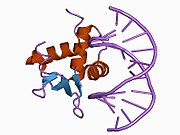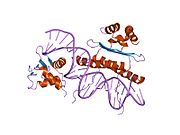Biology:ELK4
From HandWiki
Short description: Protein-coding gene in the species Homo sapiens
 Generic protein structure example |
ETS domain-containing protein Elk-4 is a protein that in humans is encoded by the ELK4 gene.[1][2][3]
Function
This gene is a member of the Ets family of transcription factors and of the ternary complex factor (TCF) subfamily. Proteins of the TCF subfamily form a ternary complex by binding to the serum response factor and the serum response element in the promoter of the c-fos proto-oncogene. The protein encoded by this gene is phosphorylated by the kinases, MAPK1 and MAPK8. Several transcript variants have been described for this gene.[3]
Interactions
ELK4 has been shown to interact with:
References
- ↑ "Mapping of the human SAP1 (SRF accessory protein 1) gene and SAP2, a gene encoding a related protein, to chromosomal bands 1q32 and 12q23, respectively". Genomics 23 (3): 710–1. Mar 1995. doi:10.1006/geno.1994.1564. PMID 7851904.
- ↑ "Locations of the ets subfamily members net, elk1, and sap1 (ELK3, ELK1, and ELK4) on three homologous regions of the mouse and human genomes". Genomics 29 (3): 769–72. Mar 1996. doi:10.1006/geno.1995.9938. PMID 8575773.
- ↑ 3.0 3.1 "Entrez Gene: ELK4 ELK4, ETS-domain protein (SRF accessory protein 1)". https://www.ncbi.nlm.nih.gov/sites/entrez?Db=gene&Cmd=ShowDetailView&TermToSearch=2005.
- ↑ "c-Fos oncogene regulator Elk-1 interacts with BRCA1 splice variants BRCA1a/1b and enhances BRCA1a/1b-mediated growth suppression in breast cancer cells". Oncogene 20 (11): 1357–67. Mar 2001. doi:10.1038/sj.onc.1204256. PMID 11313879.
- ↑ "The B-box dominates SAP-1-SRF interactions in the structure of the ternary complex". EMBO J. 20 (12): 3018–28. Jun 2001. doi:10.1093/emboj/20.12.3018. PMID 11406578.
- ↑ "Interaction of ATF6 and serum response factor". Mol. Cell. Biol. 17 (9): 4957–66. Sep 1997. doi:10.1128/MCB.17.9.4957. PMID 9271374.
Further reading
- "The ETS-domain transcription factor family". Int. J. Biochem. Cell Biol. 29 (12): 1371–87. 1998. doi:10.1016/S1357-2725(97)00086-1. PMID 9570133.
- "Ets transcription factors: nuclear effectors of the Ras-MAP-kinase signaling pathway". Trends Biochem. Sci. 23 (6): 213–6. 1998. doi:10.1016/S0968-0004(98)01211-0. PMID 9644975.
- "Characterization of SAP-1, a protein recruited by serum response factor to the c-fos serum response element". Cell 68 (3): 597–612. 1992. doi:10.1016/0092-8674(92)90194-H. PMID 1339307.
- "Comparative analysis of the ternary complex factors Elk-1, SAP-1a and SAP-2 (ERP/NET)". EMBO J. 14 (11): 2589–601. 1995. doi:10.1002/j.1460-2075.1995.tb07257.x. PMID 7540136.
- "Initial assessment of human gene diversity and expression patterns based upon 83 million nucleotides of cDNA sequence". Nature 377 (6547 Suppl): 3–174. 1995. PMID 7566098. http://www.columbia.edu/itc/biology/pollack/w4065/client_edit/readings/nature377_3.pdf.
- "Characterization of SAP-1, a protein recruited by serum response factor to the c-fos serum response element". Cell 76 (2): 411. 1994. PMID 8293474. http://download.cell.com/pdf/PII0092867494903476.pdf. Retrieved 2011-06-29.
- "Activation of the Sap-1a transcription factor by the c-Jun N-terminal kinase (JNK) mitogen-activated protein kinase". J. Biol. Chem. 272 (7): 4219–24. 1997. doi:10.1074/jbc.272.7.4219. PMID 9020136.
- "Convergence of MAP kinase pathways on the ternary complex factor Sap-1a". EMBO J. 16 (7): 1620–7. 1997. doi:10.1093/emboj/16.7.1620. PMID 9130707.
- "p38-2, a novel mitogen-activated protein kinase with distinct properties". J. Biol. Chem. 272 (31): 19509–17. 1997. doi:10.1074/jbc.272.31.19509. PMID 9235954.
- "Structures of SAP-1 bound to DNA targets from the E74 and c-fos promoters: insights into DNA sequence discrimination by Ets proteins". Mol. Cell 2 (2): 201–12. 1998. doi:10.1016/S1097-2765(00)80130-6. PMID 9734357.
- "Id helix-loop-helix proteins inhibit nucleoprotein complex formation by the TCF ETS-domain transcription factors". EMBO J. 18 (4): 968–76. 1999. doi:10.1093/emboj/18.4.968. PMID 10022839.
- "Activation of the protein kinase ERK5/BMK1 by receptor tyrosine kinases. Identification and characterization of a signaling pathway to the nucleus". J. Biol. Chem. 274 (37): 26563–71. 1999. doi:10.1074/jbc.274.37.26563. PMID 10473620.
- "c-Fos oncogene regulator Elk-1 interacts with BRCA1 splice variants BRCA1a/1b and enhances BRCA1a/1b-mediated growth suppression in breast cancer cells". Oncogene 20 (11): 1357–67. 2001. doi:10.1038/sj.onc.1204256. PMID 11313879.
- "The B-box dominates SAP-1-SRF interactions in the structure of the ternary complex". EMBO J. 20 (12): 3018–28. 2001. doi:10.1093/emboj/20.12.3018. PMID 11406578.
- "Crystal structure of a ternary SAP-1/SRF/c-fos SRE DNA complex". J. Mol. Biol. 314 (3): 495–506. 2002. doi:10.1006/jmbi.2001.5138. PMID 11846562.
External links
- ELK4+protein,+human at the US National Library of Medicine Medical Subject Headings (MeSH)
- FactorBook ELK4
This article incorporates text from the United States National Library of Medicine, which is in the public domain.
 |





